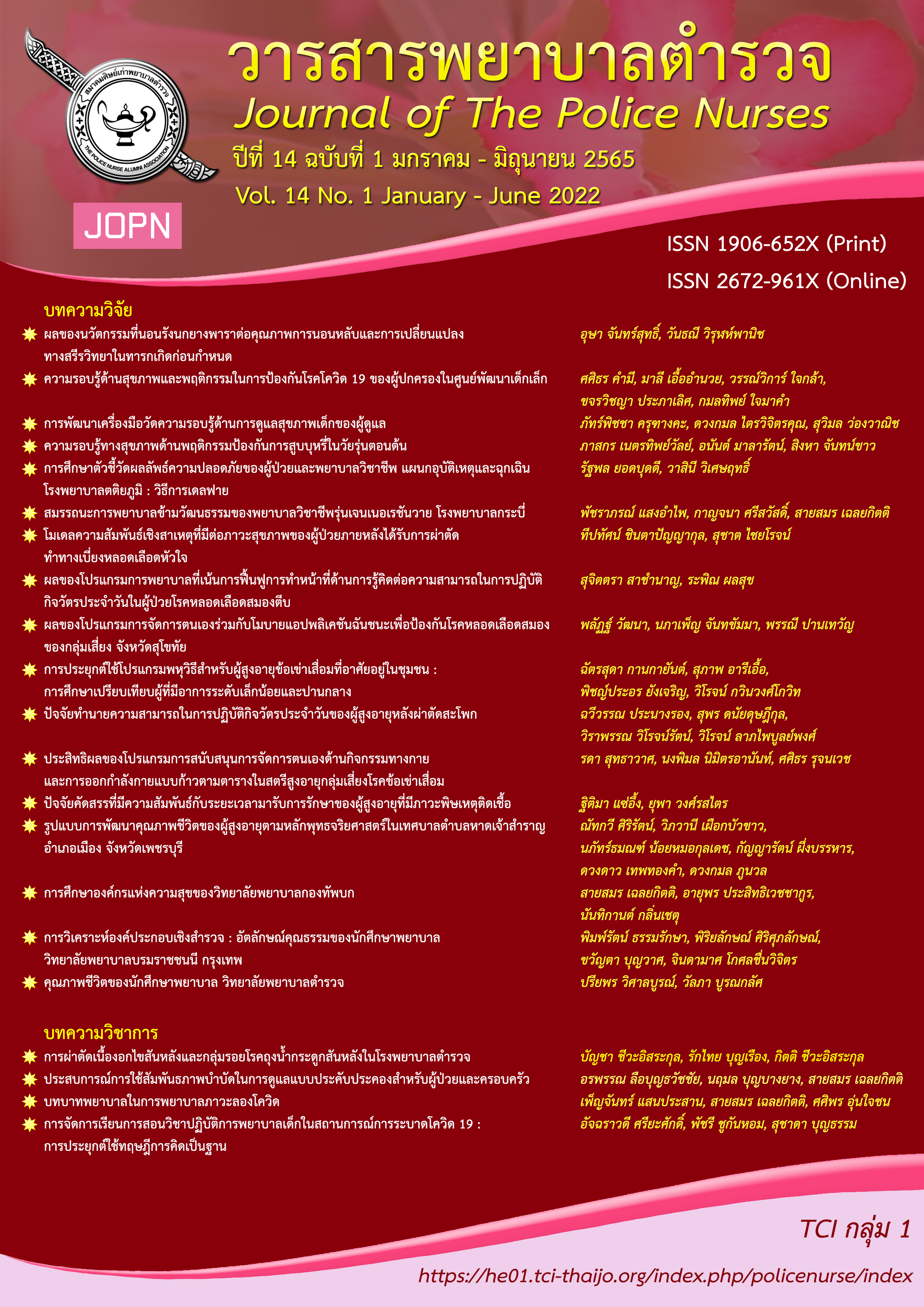การประยุกต์ใช้โปรแกรมพหุวิธีสำหรับผู้สูงอายุข้อเข่าเสื่อมที่อาศัยอยู่ในชุมชน : การศึกษาเปรียบเทียบผู้ที่มีอาการระดับเล็กน้อยและปานกลาง
คำสำคัญ:
ผู้สูงอายุ, ข้อเข่าเสื่อม, ความรุนแรงโรคข้อเข่าเสื่อมบทคัดย่อ
การวิจัยครั้งนี้เป็นวิจัยกึ่งทดลอง มีวัตถุประสงค์เพื่อศึกษาผลของการประยุกต์ใช้โปรแกรมพหุวิธีในผู้สูงอายุข้อเข่าเสื่อมที่อาศัยอยู่ในชุมชน โดยเปรียบเทียบคะแนนเฉลี่ยความรู้โรคข้อเข่าเสื่อม การรับรู้ความเจ็บป่วยโรคข้อเข่าเสื่อม ความผาสุกทางใจ และ ผลลัพธ์ทางสุขภาพ (อาการปวดข้อเข่า และ พิสัยการเคลื่อนไหวข้อเข่า) ก่อนและหลังได้รับโปรแกรมทดลอง กลุ่มตัวอย่างคือผู้สูงอายุโรคข้อเข่าเสื่อมในชุมชน จำนวน 50 คน แบ่งเป็นกลุ่มทดลองที่ 1 (อาการระดับเล็กน้อย) จำนวน 25 คน กลุ่มทดลองที่ 2 (อาการระดับปานกลาง) จำนวน 25 คน ทั้งสองกลุ่มได้รับโปรแกรมพหุวิธีประกอบด้วย โปรแกรมการให้ความรู้ความเข้าใจโรคข้อเข่าเสื่อม โปรแกรมการลด/ควบคุมน้ำหนัก โปรแกรมออกกำลังกายบริหารกล้ามเนื้อต้นขา และโปรแกรมเยี่ยมบ้าน ติดตามผลภายหลังทดลอง 8 สัปดาห์
เก็บรวบรวมข้อมูลโดยการตอบแบบสอบถาม และตรวจร่างกาย วิเคราะห์ข้อมูลด้วยสถิติบรรยาย สถิติไควสแควร์ สถิติวิเคราะห์ความแปรปรวนพหุคูณแบบวัดซ้ำ
ผลการศึกษาพบว่า หลังการทดลองกลุ่มทดลองทั้งสองกลุ่ม มีคะแนนเฉลี่ยความรู้โรคข้อเข่าเสื่อม การรับรู้ความเจ็บป่วยโรคข้อเข่าเสื่อม อาการปวดข้อเข่า และพิสัยการเคลื่อนไหวข้อเข่าดีขึ้นกว่าก่อนการทดลองอย่างมีนัยสำคัญทางสถิติ (p < .05) เมื่อเปรียบเทียบระหว่างกลุ่มทดลอง พบว่า คะแนนเฉลี่ยความรู้โรคข้อเข่าเสื่อม การรับรู้ความเจ็บป่วยโรคข้อเข่าเสื่อม อาการปวดข้อเข่า และพิสัยการเคลื่อนไหวข้อเข่าดีขึ้นแตกต่างกัน อย่างไม่มีนัยสำคัญทางสถิติ การศึกษาครั้งนี้จึงอาจสรุปได้ว่า โปรแกรมพหุวิธีสามารถนำไปใช้กับผู้สูงอายุข้อเข่าเสื่อมที่มีระดับความรุนแรงเล็กน้อยถึงระดับปานกลางโดยส่งผลให้ผู้สูงอายุที่มีอาการของโรคข้อเข่าเสื่อมเกิดผลลัพธ์ทางสุขภาพที่ดี
Downloads
เอกสารอ้างอิง
Alfieri, F. M., Silva, N., & Battistella, L. R. (2017). Study of the relation between body weight and functional limitations and pain in patients with knee osteoarthritis. Einstein (Sao Paulo, Brazil), 15(3), 307–312. https://doi.org/10.1590/S1679-45082017AO4082
Anderson, A. S., & Loeser, R., F. (2010). Why is osteoarthritis an age-related disease? best practice & research. Clinical Rheumatology, 24(1), 15.
Aree-ue, S., Vanavanant, S., & Roopsawang, I. (2016). Selected factors predicting health status among persons with knee osteoarthritis. Journal of Public Health Nursing,30(1), 28-46.
Aree-Ue, S., & Piyakhachornrot, N. (2008). Outcomes of health education and home-based exercise programs for patients with knee osteoarthritis. Thai Journal of Nursing Council, 23(3), 73-84.
Aree-Ue, S., Saraboon, Y., & Belza, B. (2017). Long-term adherence and effectiveness of a multi-component intervention for community-dwelling overweight Thai older adults with knee osteoarthritis: 1-year follow up. Journal of Gerontological Nursing, 4, 40-48. https://doi.org/10.3928/00989134-20170111-09
Aree-Ue, S., & Youngcharoen, P. (2020). The 6 Item cognitive function test- Thai version: Psychometric property testing. Ramathibodi Nursing Journal, 26(2), 188-202.
Bar-Or, D., Rael, L. T., Thomas, G. W., & Brody, E. N. (2015). Inflammatory pathways in knee osteoarthritis: potential targets for treatment. Current Rheumatology Reviews, 11(1), 50–58. https://doi.org/10.2174/1573397111666150522094131
Bhatia, D., Bejarano, T., & Novo, M. (2013). Current interventions in the management of knee osteoarthritis. Journal of Pharmacy & Bioallied Sciences, 5(1), 30–38. https://doi.org/10.4103/0975- 7406.106561
Broadbent, E., Petrie, K. J., Main, J., & Weinman, J. (2006). The brief illness perception questionnaire. Journal of psychosomatic research, 60(6), 631-637.
Cheng, S. T., Chan, K. L., Lam, R., Mok, M., Chen, P. P. Chow, Y. F., Chung, J., Law, A., Lee, J., Leung, E., & Tam, C. (2017). A multicomponent intervention for the management of chronic pain in older adults: Study protocol for a randomized controlled trial. Trials, 18(1), 528.
Choojaturo, S., Sindhu, S., Utriyaprasit, K., & Viwatwongkasem, C. (2019). Factors associated with access to health services and quality of life in knee osteoarthritis patients: A multilevel cross-sectional study. BMC Health Services Research, 19. https://doi.org/10.1186/s12913-0194441
Foundation of Thai Gerontology Research and Development Institute. (2014). Situation of the Thai elderly 2014. Bangkok. Retrieved from https://www.msociety.go.th/article_attach/16057/19114.pdf
Gustafson, J. A., Gorman, S., Fitzgerald, G. K., & Farrokhi, S. (2016). Alterations in walking knee joint stiffness in individuals with knee osteoarthritis and self-reported knee instability. Gait Posture, 43, 210-215.
Hall, A. K., Cole-Lewis, H., & Bernhardt, J. M., (2015). Mobile text messaging for health: A systematic review of reviews. Annual Review of Public Health, 18(36), 393-415.
Hanrungcharotorn, U., Pinyopasakul, W, Pongthavornkamol, K., Dajpratham, P., & Beeber, A. S. (2021). Factors influencing physical activity among women with osteoarthritis of the knee. Pacific Rim International Journal of Nursing Research, 21(1), 5-17.
Hernandez, E. M., Margolis, R., & Hummer, R. A. (2018). Educational and gender differences in health behavior changes after a gateway diagnosis. Journal of aging and health, 30(3), 342-364.
Leventhal, H., Brissette, I., & Leventhal, E. A. (2003). The Commonsense model of self-regulation of health and illness. In L. D. Cameron & H. Leventhal (Eds.), The self-regulation of Health and Illness behavior (pp. 42-65). London: Routledge.
Nicolson, P. J., Bennell, K. L., Dobson, F. L., Van Ginckel, A., Holden, M. A., & Hinman, R. S. (2017). Interventions to increase adherence to therapeutic exercise in older adults with low back pain and/or hip/knee osteoarthritis: A systematic review and meta-analysis. British journal of sports medicine, 51(10), 791-799.
O'Neill, T. W., & Felson, D. T. (2018). Mechanisms of osteoarthritis (OA) pain. Current Osteoporosis Reports, 16(5), 611–616.
Ro, D., Han, H., Kim, B., Lee, S., & Lee, M. (2016). Gender difference in knee joint loading: Cross-sectional study in normal geriatric population. Osteoarthritis and Cartilage, 24, S122.
Roach, K. E., & Miles, T. P. (1991). Normal hip and knee active range of motion: The relationship to age. Physical therapy, 71(9), 656-665.
Roman-Blas, J. A., Castañeda, S., Largo, R., & Herrero-Beaumont, G. (2009). Osteoarthritis associated with estrogen deficiency. Arthritis Research & Therapy, 11(5), 241.
Saraboon, Y., Aree-Ue, S., & Maruo, S. J. (2015). The effect of multifactorial intervention programs on health behavior and symptom control among community-dwelling overweight older adults with knee osteoarthritis. Orthopaedic Nursing, 34(5), 296-308.
Sims, E. L., Carland, J. M., Keefe, F. J., Kraus, V. B., Guilak, F., & Schmitt, D. (2009). Sex differences in biomechanics associated with knee osteoarthritis. Journal of women & aging, 21(3), 159-170.
Sroisong, S., Rueankon, A., Fuongtong, P., & Srathong, P. (2019). Nursing care for elderly people with knee osteoarthritis. Region 11 Medical Journal, 33(2), 197-209.
Thongsuk, Y., Vatanasin, D., & Hengudomsub, P. (2019). Factors influencing psychological well-being among older adults. The Journal of Psychiatric Nursing and Mental Health, 33(1), 95-110.
Wallace, I. J., Worthington, S., Felson, D. T., Jurmain, R. D., Wren, K. T., Maijanen, H., . . . Lieberman, D. E. (2017). Knee osteoarthritis has doubled in prevalence since the mid-20th century. Proceedings of the National Academy of Sciences, 114(35), 9332-9336.
Wise, B. L., Niu, J., Zhang, Y., Wang, N., Jordan, J. M., Choy, E., & Hunter, D. J. (2010). Psychological factors and their relation to osteoarthritis pain. Osteoarthritis and Cartilage, 18(7), 883–887. https://doi.org/10.1016/j.joca.2009.11.016
Wichitsiri, P., & Sawangsopakul, B. (2012). Wisdom, social support and psychological well-being of elderly in the elderly club at Wat Sarod Rat Burana district, Bangkok. Journal of Social Sciences and Humanities, 38(2), 139-151.
ดาวน์โหลด
เผยแพร่แล้ว
รูปแบบการอ้างอิง
ฉบับ
ประเภทบทความ
สัญญาอนุญาต
ลิขสิทธิ์ (c) 2022 วารสารพยาบาลตำรวจ

อนุญาตภายใต้เงื่อนไข Creative Commons Attribution-NonCommercial-NoDerivatives 4.0 International License.
ผลงานที่ได้ตีพิมพ์แล้วจะเป็นลิขสิทธิ์ของวารสารพยาบาลตำรวจ















